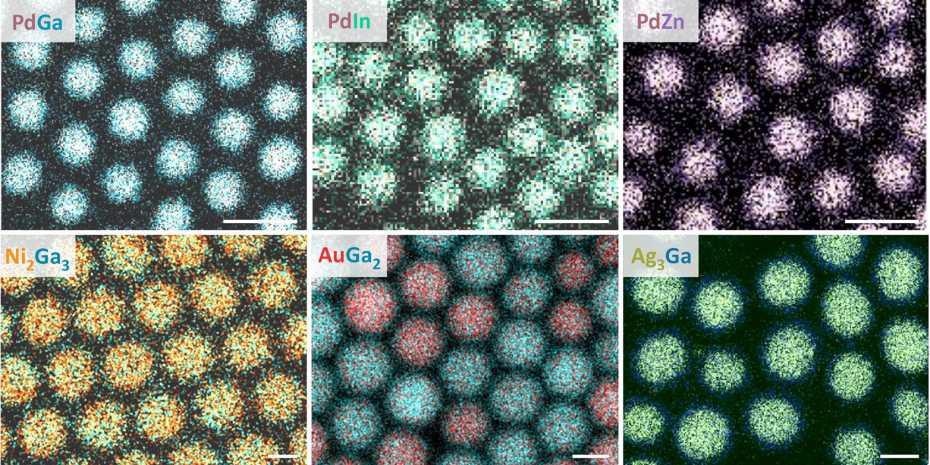Scientists at ETH Zurich have developed nanocrystals with two different metals using an amalgamation process where a solid metal is penetrated by a liquid metal.
 Intermetallic nanocrystals (electron microscope images) made from different combinations of metals. The white bar indicates 10 nm. Image Credit: Chemistry and Materials Design group.
Intermetallic nanocrystals (electron microscope images) made from different combinations of metals. The white bar indicates 10 nm. Image Credit: Chemistry and Materials Design group.
This new, remarkably intuitive method enables the production of a wide range of intermetallic nanocrystals with customized characteristics for different applications.
Nanocrystals are nanometer-sized spheres featuring a regular arrangement of atoms. Thanks to their beneficial characteristics, they find use in numerous technologies. For example, semiconductor nanocrystals, are used in next-generation television screens.
The so-called intermetallic nanocrystals, where two types of metals mix to develop a crystal lattice, have recently gained wider attention with their special and enhanced applications. Their applications range from catalysis to data storage and medicine.
In principle, tens of thousands of potential metal combinations are available with the ability to form nanocrystals along with correspondingly diverse material properties. But until now, it has only been possible to produce nanocrystals with fewer such pairings.
A research team at ETH Zurich headed by Maksym Yarema and Vanessa Wood at the Institute for Electronics has now created a new method that enables achieving almost all possible combinations of intermetallic nanocrystals.
The study results were published in the scientific journal Science Advances.
Surprisingly Intuitive Method
Our method is simple and intuitive–so intuitive, in fact, that we were surprised that no one had had this idea before us.
Maksym Yarema, Study Lead Researcher, ETH Zurich
Traditional processes for making nanocrystals with a single metal often involve adding the metal atoms in molecular form. For example, they are added as salts to a solution in which the nanocrystals then develop.
Theoretically that can also be done with two different metals, but in practice it is difficult, or even impossible, to combine distinctly dissimilar metals in the reactor.
Maksym Yarema, Study Lead Researcher, ETH Zurich
Thus, the researchers from ETH Zurich adhered to a technique, widely used for centuries — amalgamation, a unique kind of fusing or blending of metals.
Liquid Metals
Amalgams are specifically known for dentistry, where they are employed as a filling material, as well as in gold mining. In both cases, liquid mercury is used to dissolve other metals (for tooth fillings, a mixture of silver, zinc, and copper).
But the amalgamation can be used with any other liquid metal. Apart from mercury, which exists in liquid form even at room temperature, there are various other metals like indium (157 °C), gallium (30 °C), or tin (232 °C) that exhibit comparatively low melting points.
Amalgamation Approach for Nanocrystals
Yarema and his collaborators employed the amalgamation process at the nanoscale level. The reaction begins with the dispersion of nanocrystals made of a single metal, for example, silver. Further, the atoms of the second metal, like gallium, are included in molecular form (here, it is as amides, a compound of carbon, nitrogen, and hydrogen), while the mixture is heated to about 300 °C.
Yarema said, “We are amazed how efficient the amalgamation is at the nanoscale. Having one liquid metal component is the key to fast and uniform alloying within each nanocrystal.”
At first, the high temperature makes the chemical bonds in the gallium-amide breakup, enabling liquid gallium to settle on the silver nanocrystals. Then, liquid gallium creeps into the solid silver right when the actual amalgamation process begins.
With time, a new crystal lattice is developed, where the silver and gallium atoms are regularly arranged. Eventually, everything is cooled down, and after 10 minutes, the nanocrystals are formed.
We are amazed how efficient the amalgamation is at the nanoscale. Having one liquid metal component is the key to fast and uniform alloying within each nanocrystal.
Maksym Yarema, Study Lead Researcher, ETH Zurich
Controllable Process
The researchers employed the same procedure to develop different intermetallic nanocrystals like copper-gallium, palladium-zinc and gold-gallium.
The amalgamation process can itself be accurately steered. Using the number of available secondary atoms which are added into the solutions as amides, the ratio of the metals in the nanocrystals can be regulated precisely.
Considering the example of gold-gallium (chemical symbols Ga and Au), the scientists have observed that this method produces different proportions of nanocrystals. For example, 7:2 (Au7Ga2), 1:1 (AuGa), 1:2 (AuGa2).
Also, the size of the final intermetallic nanocrystals can be projected certainly from the size of the initial nanocrystals and the elevation in size caused by the second metal.
Tailored Nanocrystals for Applications
Scientists predict the huge potential for technological applications considering the precise controllability of the composition and size of the nanocrystals along with the ability to amalgamate metals nearly at will.
Yarema concluded, “Because the amalgamation synthesis of nanocrystals enables so many new compositions, we cannot wait to see them at work in improved catalysis, plasmonics or lithium-ion batteries.”
For example, catalysts build from nanocrystals can be accurately customized and improved for a certain chemical process that they are about to speed up.
Journal Reference:
Clarysse, J., et al. (2021) Size- and composition-controlled intermetallic nanocrystals via amalgamation seeded growth. Science Advances. doi.org/10.1126/sciadv.abg1934.